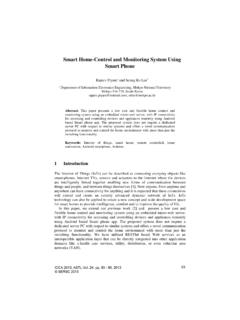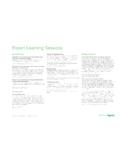Transcription of Smart power opens door to more efficient …
1 Smart power opens door to more efficient electrical useAjinder SinghGeneral manager, Building automation , Lighting & Display texas InstrumentsKripa VenkatGeneral manager, Grid Infrastructure texas InstrumentsHow intelligent will our homes and buildings become? I 2 March 2016 Smart power opens the door to more ef cient electrical useSuppose you are 1,000 miles from home, yet have the ability to monitor and control every watt of power in your home or office building from the palm of your hand. What could you do with that capability? Sometimes you might want to change the thermostat remotely, or turn on the lights and start the coffee maker.
2 But consider, too, that you could make real-time decisions on power usage based on instantaneous knowledge of power grid capacity and costs. Imagine having the knowledge and control to pad your own wallet or the company bottom line through optimal energy use and savings. At your fingertips you d have a tool for generating money, every minute of every day, and all from a smartphone. Such scenarios were visionary only a few years ago. Today they re increasingly realistic, as homeowners and landlords everywhere are taking control of energy consumption to an extent never possible before. power is becoming smarter at every stage, from its generation centrally or locally to its end use in smarter homes and buildings by the electrical devices that we use at home, at work and on the advances in power monitoring, connectivity and control known collectively as Smart power are enabled by advanced semiconductor technology.
3 texas instruments (TI) is among the technology innovators committed to Smart power development. System developers can rely on TI s in-depth expertise and long-term product development in power , network communications and control circuitry to deliver greater intelligence into the generation, transmission and consumption of power generationPower generation and transmission are undergoing a slow but steady evolution to smarter, finer-grained supply when and where energy is needed. On an industrial scale, service providers are investing in alternative sources of energy such as solar and wind farms, as well as working to utilize central power stations more efficiently.
4 power equipment is also becoming more intelligent and increasingly is data-networked in order to minimize transmission, connection and conversion , supplying energy is no longer the task of service providers alone. Residential and commercial buildings are becoming energy generators as well, with small-scale installations in wind and, especially, solar technology. For small producers, Smart power manages the production, storage and use of electricity, as well as enabling them to feed electricity into the grid at times of over generation. I 3 March 2016 Smart power opens the door to more ef cient electrical useEnabling smarter homes and buildingsIntelligent power use is increasingly benefiting homes and office buildings.
5 Sensors direct lights to dim or turn on and off, and to increase or decrease ventilation, depending on the presence of people in the space. Energy networks may include features such as software that analyzes power usage by individual areas, applications and equipments. Such programs help to determine whether equipment needs to be replaced, either because inefficient operation makes it costly, or because it is critical and must not fail. An energy network is also essential if the building generates electricity via solar or wind energy landlords who invest in Smart power systems find that their electrical spending goes down considerably, and they often save enough to pay back the installation investment through increases in productivity that result from keeping the workspace comfortable.
6 In addition, since the need for power is ubiquitous, it makes sense to extend the concept of Smart power to enable Smart buildings. Networks with connected applications such as structural monitors, security systems, smoke detectors and motion and occupancy sensing serve to create a management-savvy nervous system for the entire building. Technology for smarter powerA number of different technologies are used to enhance the energy management of buildings, not to mention other forms of building monitoring that may be closely coupled. Sensors detect ambient temperature, body heat, light levels, carbon dioxide levels and a variety of other conditions, such as the presence of vibrations, smoke and hazardous chemicals.
7 Area control units monitor the data from different sensors and initiate actions such as dimming lights, redirecting ventilation, changing thermostat settings and other factors. Master control units run complex software that analyzes the activity of the entire network in order to provide operational evaluation, equipment alerts, cost breakdowns and other systems all depend on communications via wired or wireless media, and at various points signal conversion, microcontrollers (MCUs) and other logic, memories and different forms of interface circuitry are used. power management circuitry is used in all units, and it is especially important for regulating, converting and controlling the generation of electricity by alternative energy sources and its storage in semiconductor requirementsBecause Smart power systems are varied, so are the requirements made on semiconductor technology.
8 Sensors are usually small, independently operating systems that can exist in great numbers, sometimes in locations that are hard to access. In addition to the sensing element itself, a sensor often requires signal conversion circuitry to Smart homes are becoming energy generators to manage production, storage and energy usage. I 4 March 2016 Smart power opens the door to more ef cient electrical usechange analog signal inputs to digital data, a small amount of memory and logic, a communications interface and a transmitter for reporting the data via a wired or wireless link.
9 The key requirements for these units are normally small size, affordable cost, and since they may have to operate from a battery for extended periods without maintenance ultra-low power control units, which may be housed with switches, thermostats and other circuitry, require the above elements plus additional control logic and memory and the ability to receive and transmit data for control and reprogramming. In a commercial building or a house with an advanced Smart power network, several area control units report to a master control unit. This unit in turn may be networked with the Internet, the regional electric grid and other building-level and external network communication challenges Communications and connectivity standards among these systems are various.
10 The central, wired systems that deal with large amounts of data for analysis and planning use the Internet Protocol (IP) for most forms of data exchange, and in some cases the smaller units may send and receive IP packet data over wired or wireless connectivity links. However, wireless sensors may use a protocol such as ZigBee that is designed to minimize power consumption in local-area transmissions. Wireless connectivity systems offer a significant advantage in that they require little or no change in wired infrastructure, saving installation costs and permitting more devices to be deployed for finer-grained data gathering and control of smaller spatial zones.

















